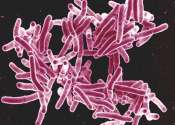Earth-sized exoplanet may have lost its original atmosphere, but gained a second one through volcanism
Orbiting a red dwarf star 41 light-years away is an Earth-sized, rocky exoplanet called GJ 1132 b. In some ways, GJ 1132 b has intriguing parallels to Earth, but in other ways it is very different. One of the differences ...









